Overview
The aloe vera plant is a succulent plant species from the genus aloe. Native to the African continent, aloes grow wild in tropical and subtropical climates all over the world, including high elevations, coastal areas, deserts and grasslands. These attractive succulents also grow in both perennial gardens and as potted plants.
Aloes produce a rosette of fleshy leaves that may be either spined or smooth, depending on the variety. Most, however, have spines that line the outer edges of the leaves, and some have spines in the center of the leaf. Spines vary in size and shape according to the variety of aloe. Colors range from green to blue-green, with some aloes sporting reddish-colored foliage. Some aloes have blotches, spots or stripes on the leaves.
Many aloes plants produce flowers on a tall slender spike, which may be branched, that grows from the center of the rosette of leaves. Flowers vary in size but are generally tubular. Flower colors range from white to brightly colored red, yellow and orange. Seeds form in dry capsules once the flowers fade. When grown as houseplants, aloes don’t bloom as profusely or often as their outdoor counterparts.
Aloes thrive on minimal care and require little moisture to survive. Like most tropical plants, aloe vera prefers a sunny location whether grown indoors or out, although it will tolerate partial shade for several hours each day. It grows best in sandy, well-drained soil and is quite tolerant of drought and dry indoor air.
Many different varieties of aloe vera exist, ranging in size, growth habit and color. Some of the bright-colored varieties are especially attractive as part of a succulent border or an indoor succulent collection.
Varieties Of Aloe vera Plant
1. Malagasy Tree Aloe (Aloe vaombe)
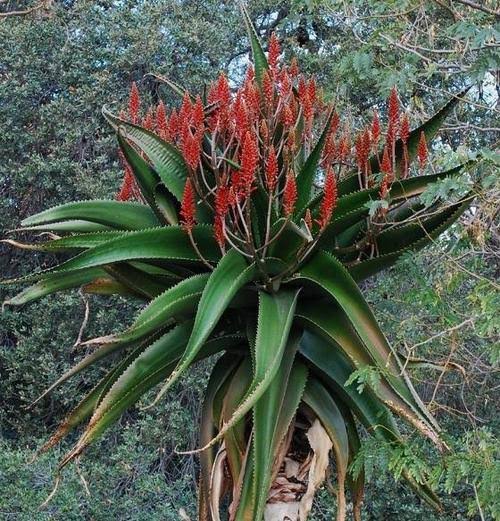
Also referred to as Aloe vaombe , Malagasy tree aloe is an unbranched succulent that grows to 12 feet or taller, with large single rosettes of 5 feet in diameter. It has long, smooth, recurved green leaves with white teeth. These leaves are curved and cup shaped when viewed in cross section and take on a deep red color in cold or sun. Native to southern Madagascar, Malagasy tree aloe is one of the showiest of the tall aloes.
Its fiery, deep-red, tubular flowers are borne in erect branched racemes in mid-winter, attracting bees and birds. Planted in full sun and watered sparingly once established, the plant grows much faster and becomes fuller with regular irrigation.
2. Candelabra Aloe (Torch Aloe)

The Torch aloe grows into a dense mounding shrub comprised of many entangled stems with rosettes of thick succulent leaves. Mature plants grow 6-12 ft. tall and spread 10-12 ft. across and wider. Leaves are pale to medium green in color and have numerous knobby spines on the margins.
In winter, large, conical, bright red to orange flower spikes are borne in profusion above the foliage. The inflorescences are usually unbranched, with two or more arising from a single rosette. Offsets normally appear around the base when plants are two or three years old.
Torch aloe can serve as the anchor plant in mixed succulent plantings in hot and sunny garden locations. Also, both its size and bold winter flowering make it well suited as an accent plant. Its flowers are highly attractive to nectar-seeking birds like hummingbirds.
Also Read: Different Types of Flowering Cactus For Your Yard
3. African Or Tiger Aloe

This fast, low-growing aloe produces short, stem-less rosettes and many offshoots that grow in low clumps. This plant will grow rapidly to twelve inches or more, producing many offsets over its lifetime. It has thick, succulent, pale green foliage with distinctive white speckles. Sharp, brown teeth are visible along its leaf margins.
In late spring or summer, it produces a purple flower stalk that is two feet tall with yellow, orange, or red tubular blossoms. The flowers attract hummingbirds. The plant can be used in rock and cactus gardens, in colorful containers, or as an understory plant beneath a tree or large shrub.
4. Cape Aloe (Aloe ferox)
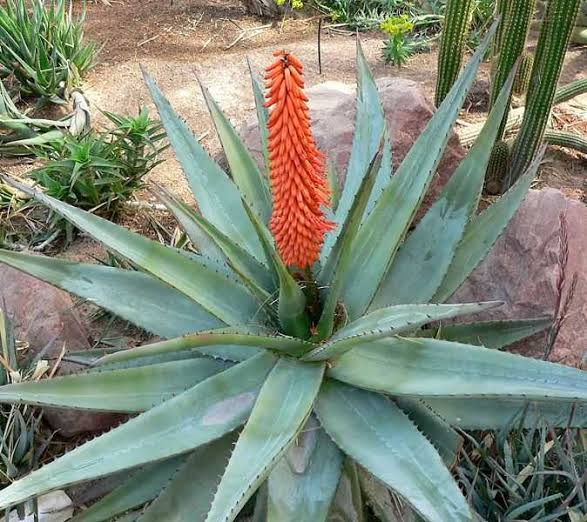
Cape aloe also referred to as bitter aloe is an impressive desert accent plant that forms a dense clump of bluish-green, fleshy, succulent leaves. The foliage is pointed at the tip and edged with sharp teeth along the margins. The fast-growing plant develops whorls of new foliage from its center. Older leaves dry and may leave a petticoat of growth on the stem. In late winter to early spring, it produces a large, candelabra-like, exquisite flower head. Each spike holds colorful orange to red or yellow blossoms. The blooms attract birds, bees, and butterflies.
It is native of South Africa where it grows in a broad range of habitats form the south and Western Capes through southern KwaZulu-Natal. This plant grows in the bush and along rocky slopes in large numbers, where it creates an amazing winter display of color when in bloom.
5. Arabian Aloe (Aloe rubroviolacea)
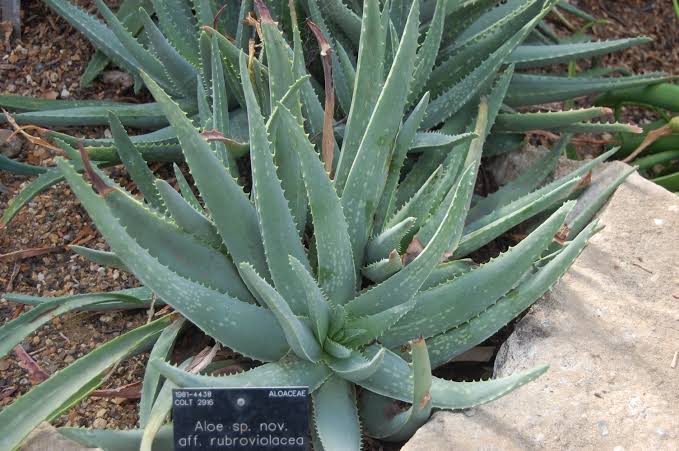
Aloe rubroviolacea (Arabian aloe) is a beautiful species from the mountains of northern Yemen and adjacent Saudi Arabia. It is a particularly beautiful evergreen succulent forming rosettes of thick leaves which arch gracefully outward. Blue-green in partial shade, with contrasting reddish teeth and margins, the leaves get purple tinged in full sun, a coloration which intensifies to violet-red hues in winter.
The leaves emerge from thick stems, which elongate over time and allow the head of this plant to sprawl, with offsets appearing around the base to form a small clump. Dense spires of red flowers are produced in winter atop unbranched flower stalks, making a great show each year.
6. Barbados Aloe
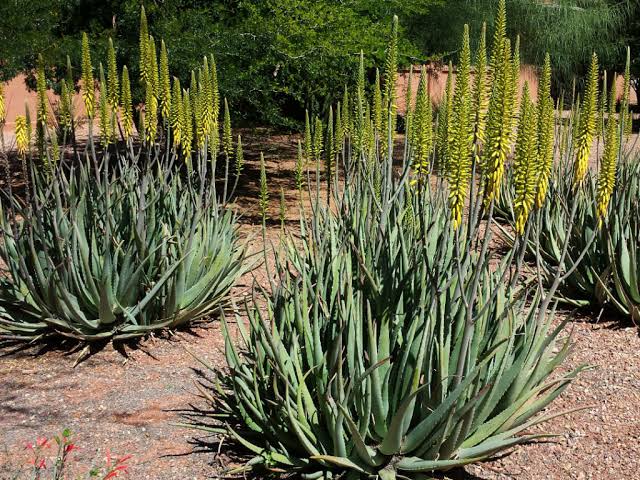
Barbados Aloe also referred to as Medicinal aloe reaches eighteen inches to two feet tall and six feet wide. It has clumping, thick, fleshy leaves and produces many offsets over a period of time. The plant is noted for its light to medium green, speckled, succulent, fleshy leaves, armed with whitish-red teeth along its margins. Its one-inch blooms appear in spring and grow high above the plant with yellow spikes in tubular clusters. Hybrids of this species may bloom in an orangey-red color.
Barbados aloe can be used as an understory plant, an accent or specimen planting in low-water-use, desert landscapes. It can also be planted in combination with cactus and other succulents in rock gardens, containers and planters. It is a great choice to use in medians and along roadways.
7. Mountain Aloe (Aloe marlothii)
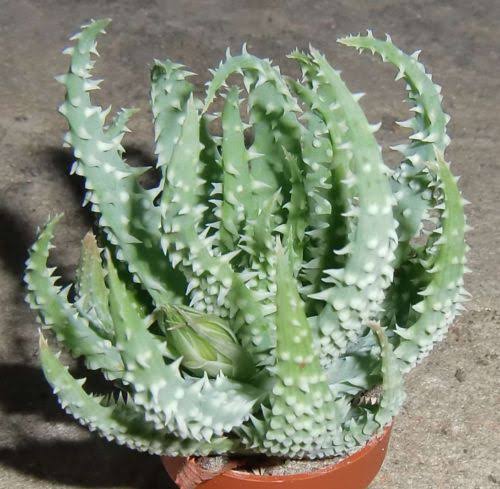
Mountain aloe also referred to as the flat-flowered aloe is a large, impressive, single-stem aloe which grows to ten feet or more. The plant has a broad base and tapers as it grows upward. Older foliage forms a dry skirt around the plant. Its new foliage is broad, heavy, and grayish-green with reddish-brown teeth that form along the margins and randomly occur along its orange leaf tips.
This plant has thorns along the stems that help protect it from browsing animals that might eat the foliage. It produces striking flowers in colors of orange, yellow, or red form on branched candelabra-like stalks in early spring. They are somewhat slanted or flat, giving this plant its common name. The flowers are very rich in nectar and attract hummingbirds.
After the flowers bloom, dry, papery-thin seeds appear and are dispersed by winds. The plant can be used as a specimen in low-water-use gardens or planted next to large boulders and tall walls as a silhouette or accent plant.
Also Read: Different Desert Plants You Need To Know
8. Snake Aloe (Aloe broomii)

Aloe broomii (Snake aloe) is a robust type of perennial aloe forming a large, short-stemmed, dense rosette of light green leaves. They are adorned with reddish brown teeth along the edges, which curl interestingly along the outer edges of each leaf.
This aloe develops a stunning, densely flowered, candle-like inflorescence, in which the buds and pale lemon flowers are covered by white long bracts. This makes this Aloe quite unique as the buds and open flowers are completely hidden by their large bracts and cannot be seen.
Snake aloe is usually solitary, but occasionally the heads divide to form groups of up to 3 rosettes. It is an ideal water-wise plant, perfectly suited to arid and semi-arid regions and it is frost resistant.
9. Coral Aloe

Coral Aloe also referred to as Aloe striata has attractive, broad, bluish-green, smooth leaves and coral red blossoms. It grows two to three feet tall and two feet wide. Unlike other aloes with serrated leaves or a spine, it has a smooth, pink margin. This aloe will grow in large, solitary clumps and has a nice appearance even when it is not in bloom. When grown in full sun, the leaves turn red.
When grown in the shade, the leaves are a bluish-green. It flowers during the winter months, producing a coral red blossom in upright inflorescences. The nectar from its blooms attracts many insects and hummingbirds during the cooler season, when most flower food is not available. The plant can be used as an accent plant for its bold, textured foliage or in containers for its winter color. It can also be mixed with other aloe species in masses.
10. Tilt-Head Aloe
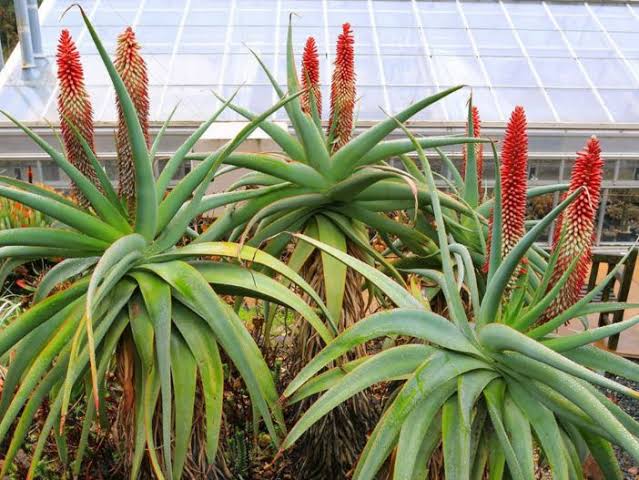
Tilt-Head Aloe is a tall, upright growing, solitary to branched aloe that reaches up to 6m in height. Its leaves are blue-green and have serrated, pale red leaf margins. The leaves can be used to dye wool a delicate pink color. The large cylindrical flower heads display striking red buds that open up during springtime to reveal green-white and red-pink, tubular flowers. It is easily distinguished by the head of rosette leaves that are permanently tilted.
The plant can be used as an ornamental in low-water-use gardens, or mix with other drought-resistant aloe species as a desert accent. Also, it can be planted in containers and raised planters with other succulents, or used as a bank cover in warmer, protected areas.
11. Climbing Aloe

Aloiampelos ciliaris, formerly Aloe ciliaris, the common climbing-aloe, is a thin, tough, rapidly growing type of aloe vera species. They can be differentiated from other Aloiampelos species by the way that the soft, white, hair-like teeth (ciliaris) that grow along the margins of the leaves, extend all the way around the stem, at the base of the leaf.
The fleshy leaves themselves are strongly recurved (helping to anchor the tall stems in dense thickets and assist the plant in climbing). The leaf sheaths are conspicuously striped green and white. These plants grow very quickly, producing long, thin, untidy stems that shoot upwards, producing large bright orange-red flowers once they reach the sun. If there are no nearby trees to act as host and support, it just forms a straggly shrub.
Also Read: Major Types of Echeveria Plants
12. Hairy Aloe
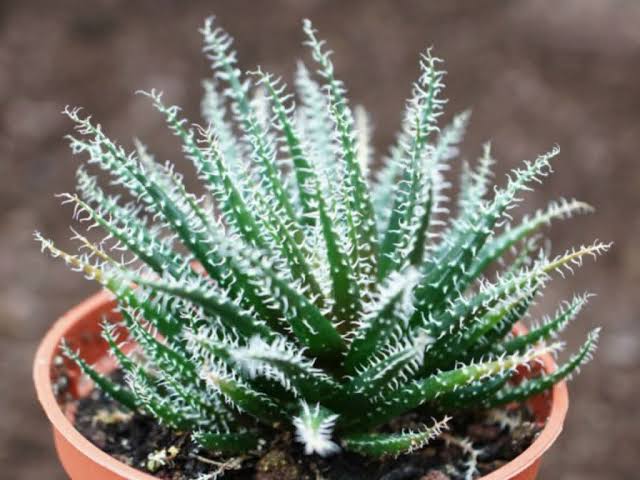
This aloe gets its name from its unique greenish-white flowers that are covered in thick wool. Its species name, tomentosa, means dense wool. The plant forms a large, solitary rosette to two feet tall and about four feet wide. It is a stem-less plant with thick, fleshy, pale green foliage, tapering from a wide base with pointed tips.
In late spring through early summer, it develops its tall, branching, unique flower stalk with the wooly flowers. The plant can be used in low-water-use gardens with other aloe species or planted in large containers and raised planters. It can also be used in rock gardens and among large boulders as an interest plant.
13. Fan Aloe

Fan Aloe is a unique and striking much-branched shrub or small tree. This plant was previously called Aloe plicatilis. It is a slow growing species with thick branching stems slowly growing 5-6 ft. tall and as wide. Large specimens may reach a height of 3-5 m. The Fan aloe is a perfect container, raised planter and rock garden plant in both residential and commercial plantings.
The stems are forked with clusters of strap-shaped leaves arranged in two opposite rows. The clusters resemble an open fan, hence the common name fan aloe. This unusual arrangement and shape of the leaves is what makes this species unique. The leaves are dull or grey-green in color, with the margins almost smooth, except for some small teeth in the upper part. Orange flowers occur on unbranched spikes in early spring.
14. Dawe’s Aloe
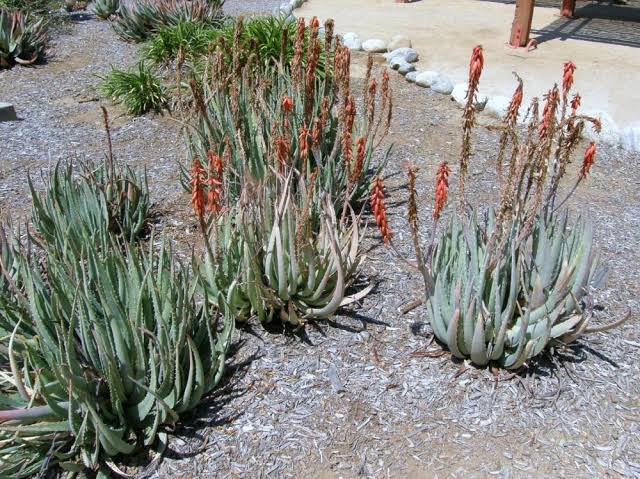
This evergreen jewel has clumping, upright clusters of elongated succulent stems and green, fleshy leaves with dark serrated teeth along the edges. It grows two to three feet tall and eighteen inches to three feet wide forming many offsets.
In mid to late winter, it sends up a tall, brilliant orangey-red flower stalk from the center of the plant. This type of aloe can be used for it for its colorful flower display during the winter in containers and planters. This growing accent works well as an understory plant, in the shade of larger shrubs and trees. It can also be mixed in masses with other aloes, succulents, and low-water-use plants.
15. Lace Aloe (Guinea-fowl aloe)

Aristaloe aristata, known as guinea-fowl aloe or lace aloe has fleshy, soft-spined dark green leaves, which have white bumps. As the weather changes, the leaves tend to change color and orange-red flowers grow on the long stems.
The leaves of this plant are triangular and are covered with white spikes and fine cilia, which are a common identifier of the Asphodelaceae plant family. The torch plant can grow up to 16-18″ inches (40-45cm). Its branches are covered with peach-colored flowers in the summer, which helps attract bees.
The Lace Aloe is an easy to grow flowering succulent for both residential and commercial plantings. It is well suited for use in containers, rock gardens and planted in large groupings to achieve a bold planting pattern.
Also Read: Different Types of Euphorbia Plants
16. Golden Toothed Aloe (Aloe nobilis)

Golden Toothed Aloe is believed to be a hybrid and does not occur naturally. It a low-growing, clumping aloe reaches about one foot tall and wide with many clustering offsets. It has thick, succulent, short, green leaves that grow in rosettes with large, yellow, toothed edges along the margins of the plant.
The gold tooth aloe produces tall, striking orangey-red blooms in late spring through mid summer on two feet tall stalks that grow above the plant. It has a long blooming cycle. The flowers attract bees, butterflies, and birds. The plant can be used in containers and raised planters. It can be mixed with other drought-resistant cacti and succulents in rock gardens or with boulders. It can also be used as an accent, in edging gardens, along small, entry beds, and in masses.
17. Tiger Tooth Aloe (Aloe juvenna)
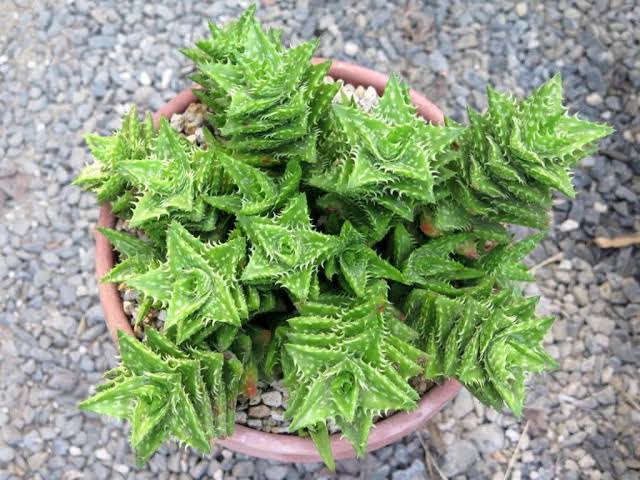
Tiger Tooth Aloe also (Aloe juvenna) is a small, clump-forming succulent, with erect stem up to 30 cm long, branching at the base. The leaves are bright green (reddish to brown in full sun), toothy-margined and flecked with cream-white prominent spots. The flowers are coral-pink to orange-red, with yellow-green mouth. Tiger tooth aloe plants do not often flower, although when they do, they flower in summer or autumn.
It is frequently confused with Aloe squarrosa from Kenya. However the commoner Aloe juvenna has shorter, straight, non-recurved triangular leaves and grows long stems, with the leaves retained all along the stems.
18. Short-Leaf Aloe (Aloe brevifolia)

The low-growing, clumping aloe is stem-less and grows eighteen inches tall and nine to twelve inches wide. It forms small, tight rosettes of deep, blue-green, triangular, fleshy leaves with white spots and white teeth along its serrated edges. The leaves are flat on the top and concave on the underside of the plant. Young leaves have a reddish tint. The plant produces many offsets that can be used for propagation.
In spring, it sends up a dense, one- to two-inch, orange-scarlet flower spike. This aloe plant type can be used as a groundcover in low-water-use gardens, or in containers, small spaces and in planters for its interesting and charming appearance. It can also be used as a foundation planting or as an edging plant around rocks or small boulders.
19. Red Aloe (Aloe cameronii)
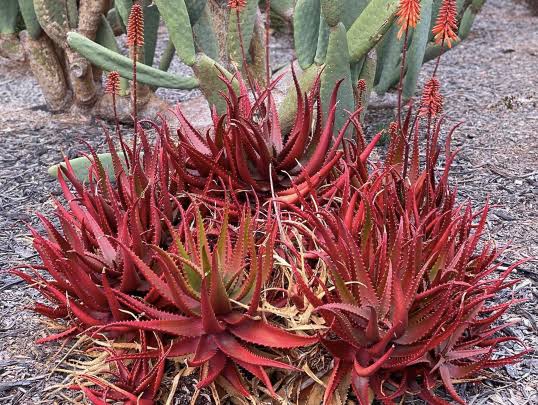
Red aloe (Aloe cameronii) holds the record of the being the most attractive foliage Aloes. It is an evergreen succulent with upright stems of open rosettes. The fleshy, gracefully curving leaves are a rainbow of colors ranging from green to a rich coppery red, depending on the sun and water.
In late fall to early winter, spikes of bright orange-red flowers are borne in profusion above the foliage, brightening up the garden. This type of aloe plant provides a colorful focal point in the Xeriscape. It is easily propagated from cuttings.
20. Aloe squarrosa
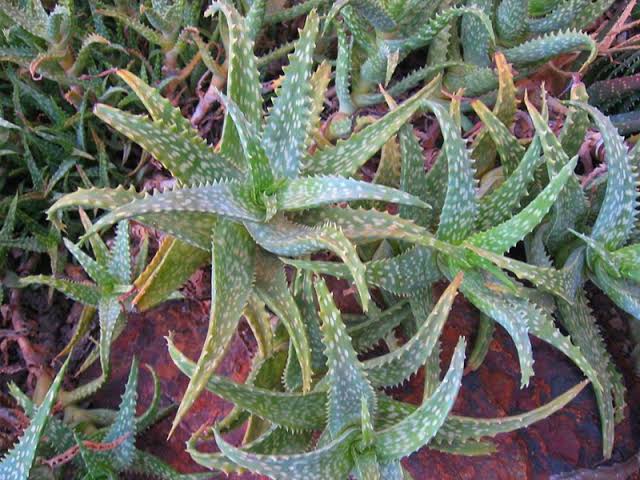
Aloe squarrosa has smooth, green, spotted leaves that curve backwards. These recurved leaves are kept only around the head or top of each stem, with dead leaves falling off the lower parts of the stem. The inflorescence is short and simple, and the flowers are light orange with green tips. It is relatively rare in cultivation.
Aloe squarrosa can be commonly mistaken for the less common Aloe Juvenna, however their growth habits differ; the Aloe juvenna grows in a tight, compact, clump-like fashion, and the Aloe squarrosa grows in a more loose way, with leaves that re-curve (bend backwards).
21. Partridge Breast Aloe (Gonialoe variegate)

This dwarf aloe with spotted white and green leaves resembles the breast of a partridge, as its common name implies. It grows in a clump and stays low to the ground, usually below one foot tall. It is one of the most distinctive and well known of the South African aloes.
Plants may be solitary, but generally form dense rosettes with many offsets, and spread through underground rhizomes. Its smooth, thick leaves are triangular in shape with ridges along their surface. The spotted foliage does not produce any spines, but has a soft surface with white edges.
The blooms appear in late spring on hanging spikes in pink, red, or yellow. After flowering, a capsule-like fruit appears, that splits into three parts, with wing-like seeds. The plant can be used in small spaces, as filler in containers or raised planters, or in tight beds. It can also be used along walkways and in foundation plantings.
Also Read: Difference Between Agave And Aloe
22. Giant Hesperaloe (Hesperaloe funifera)

This gorgeous, slow-growing evergreen has an erect, bold, striking growth habit. It produces stiff, narrow green leaves that form a massive clump of upright growth and reaches six feet tall and wide. Its leaf margins have white, stringy fibers that peel away as the plant matures.
In summer, it develops a creamy, greenish-white flower stalk that shoots out of its center. The flowers are nocturnal and pollinated by bats and hummingbirds. Its blossoms are not extremely showy and produce woody capsules with flat, black seeds after blooming. Due to its bold foliage it can be used as a desert or accent plant around pools and ponds, or in an attractive pot along a large wall or open space. It can also be used in medians or as a streetscape shrub in a mass planting for a bold effect.
23. Spiral Aloe (Aloe polyphylla)

Aloe polyphylla (Spiral Aloe) is highly regarded for its foliage that is arranged in a perfect spiral pattern. The fleshy gray-green leaves form a tight rosette that becomes a beautiful spiral, either clockwise or counterclockwise, as the plant ages.
The leaves are adorned with white to pale-green spines along their edges and a dark, purplish brown terminal spine at their tips. This Aloe rarely flowers. When it does in spring and early summer, its red to salmon-pink tubular blooms are borne on a branching spike which emerges above the foliage.
24. Sunset Aloe (Aloe dorotheae)

This low-growing aloe with stiff, shiny leaves grows two to three feet tall and twenty inches wide, producing many offsets. It forms a clump of rosettes or spirals on very short stems that stay low to the ground. Its leaves are yellowish-green to bright orange-red with sharp whitish-gray teeth that grow along the margins.
In late winter to early spring, it produces a flower stalk that grows two feet high with dark red flowers and greenish-yellow petals. This type of aloe can be used in rock gardens with other showy aloes and succulents, in containers and raised planters in protected locations, or where a splash of color is needed in a desert gardens.
25. Aloe maculata (Aloe saponaria)

Aloe maculata also referred to as soap aloe or zebra aloe is a very variable species and hybridizes easily with other similar aloes, sometimes making it difficult to identify. The leaves range in color from red to green, but always have distinctive “H-shaped” spots.
The flowers are similarly variable in color, ranging from bright red to yellow, but are always bunched in a distinctively flat-topped raceme. The inflorescence is borne on the top of a tall, multi-branched stalk and the seeds are reputedly poisonous.
26. Tree Aloe (Aloe bainesii)

Tree aloe (Aloe bainesii) is a large tree-like succulent and aloe plant relative with mottled gray stems and rosettes of greenish-gray leaves. The leaves are fleshy and bunched at the ends of branches. This tree-size aloe eventually develops massive trunks and branches; when planted in the ground it can reach 20-30 ft. tall.
Flowers vary in color from orange to rose-pink and occur on branched stems above leaves. The Tree aloe may be the perfect centerpiece for a rock garden, raised planter or focal element on a garden slope.
Also Read: Major Types of Snake Plants To Try At Home
27. Van Balen’s Aloe (Aloe vanbalenii)

This low-growing aloe forms many tight, dense rosettes reaching two feet tall and three to four feet wide. It develops many offsets with long, twisting, coppery-brown foliage in sunny exposed areas, and greener when grown in the shade. This plant has fine teeth along its leaf margins.
In late winter through early spring, it produces multiple, orangey-yellow flowers on ten feet tall spikes. The plant can be used in raised planters, small entryway beds or containers for its attractive foliage and form. It can be combined with other aloe species in rock and desert gardens.
28. Blue Elf Aloe (Aloe x ‘’Blue Elf)
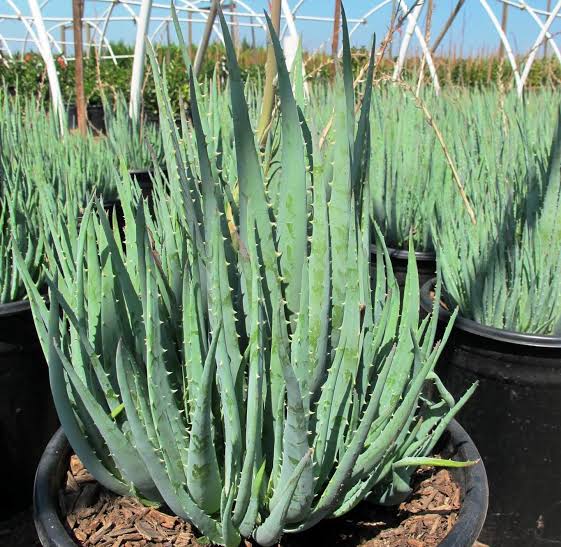
This tight-clumping, dwarf aloe offers a dense rosette and grows to eighteen inches tall and two feet wide. It is mainly stem-less with narrow, silvery-bluish-gray leaves that grow upright. There are small, sharp teeth along the margins that are reddish-brown in color.
The plant explodes with showy spikes of orangey-red blooms in late winter through early spring. This is a long-blooming aloe with lots of vibrant color, and the flowers attract hummingbirds. It also produces many offsets that can be used for propagation.
Given that this aloe is low-growing and clumping in form, it can be used in containers and rock gardens or with cacti and succulents. More importantly, it can be used in bird and hummingbird gardens, in masses with other low-water plants, or along ponds, fountains, or swimming pools.
29. Sand Aloe (Aloe hereroensis)

Aloe hereroensis (Sand Aloe) is a type of aloe plant that forms single erect rosettes or a small clump of rosettes of smooth, pale blue-green leaves that curve inwards and are often rose-colored or bronzed in the sun. The leaves are adorned with H-shaped whitish spots arranged in transverse bands on the lower surface. Their margins are lined with small, sharp, red-brown spines.
It produces flattened, branched racemes, wider than long, of usually scarlet to deep red flowers, rarely orange or yellow. Up to three branched inflorescence can rise from a single rosette. The plant can be used in raised planters, small entryway beds or containers for its attractive foliage and form. It can be combined with other aloe species in rock and desert gardens.